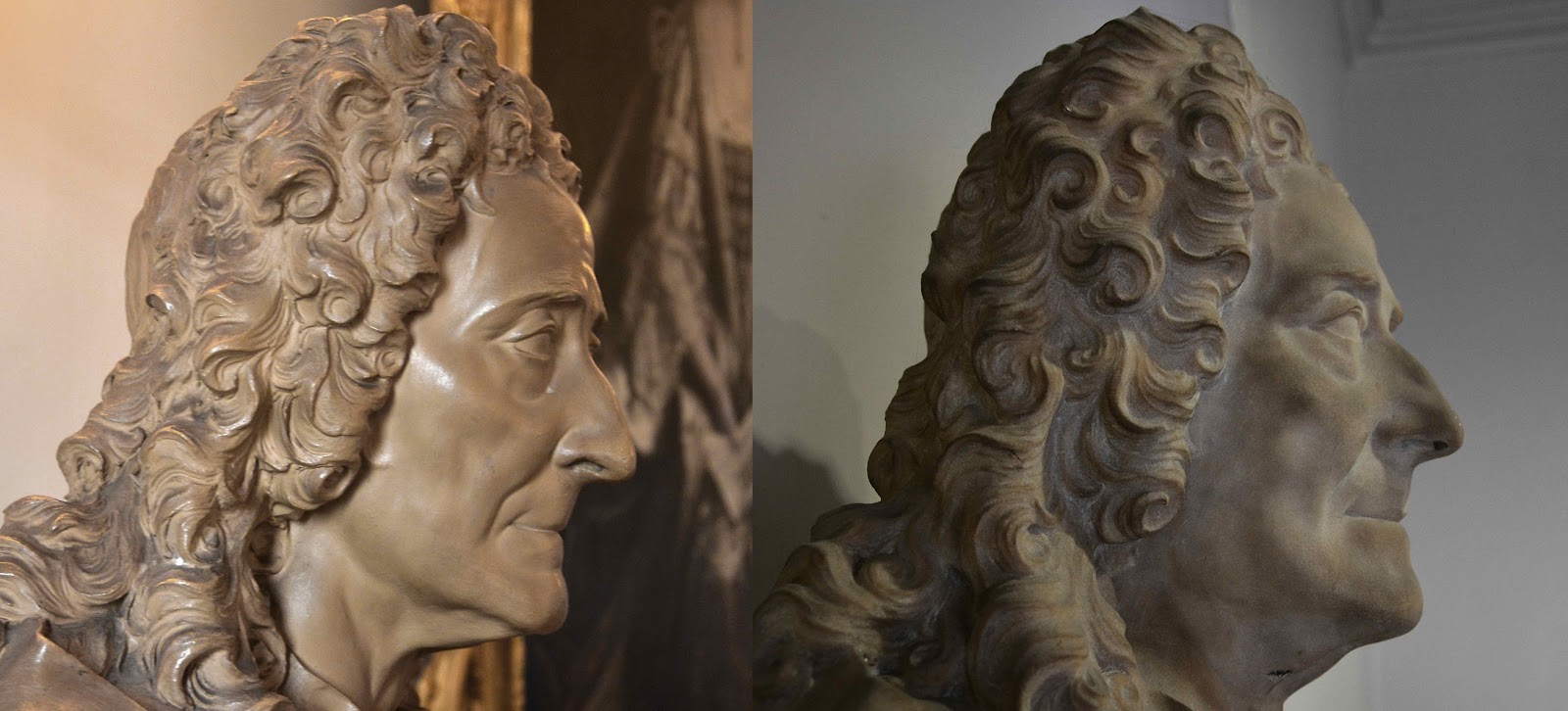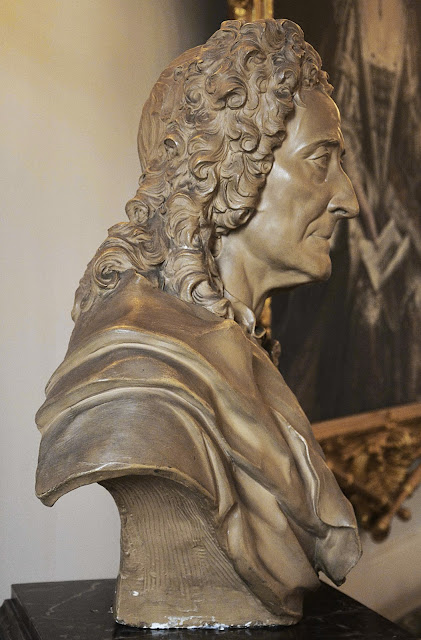John Locke (1632 - 1704.
Marble bust.
Anonymous.
Perhaps after an original by Louis Francois Roubiliac.
at Westminster School. Westminster, London.
This post is part of an ongoing investigation into the 17th and 18th Century Portrait Sculpture at Oxford and Cambridge Universities.
Readers of this blog will know that I have recently posted extensively on the lead bust of Locke by John Cheere at the Bodleian Library and the marble bust by Edward Hodges Baily at Magdalen College, Oxford.
https://bathartandarchitecture.blogspot.com/2018/01/busts-of-john-locke-and-francis-bacon.html
I am very grateful to Elizabeth Wells, Archivist at Westminster School, London for organising our visit to Westminster School, many thanks are also due to Charlotte Robinson, Assistant Archivist at Westminster School for opening doors and guiding us to the sculptures at the school and last but not least many thanks to Dana Josephson for organising the visit and suggesting the Oxford Portrait Sculpture Project to me.
I will be posting on the bust of Dr Richard Busby and Inigo Jones also at Westminster School in the near future.
The busts are all derived from the portrait by Godfrey Kneller.
John Locke.
After Godfrey Kneller.
Westminster School.
Westminster, London.
____________________________
The Putative Roubiliac Bust of Locke.
Location unknown.
The socle is a replacement and could be improved upon.
Until the bust of Locke, sold at Sotheby's Lot 148 23 March 1971 (below) reappears this will probably be my last post on the subject of the portrait sculpture of John Locke.
Image kindly supplied by Merel Dienema of the Sculpture Department at Sotheby's, Bond Street, London.
It should be noted that the quality of this missing bust is somewhat finer than the other versions of the Locke bust at Kelvingrove Museum, Glasgow, the bust of Locke noted in the collection of Harte Kingston upon Thames in 1987 (info and photograph in the Heinz Archive, NPG), and the Westminster School bust depicted below.
Particular note should be taken of the quality of the cutting of the eyes and the stitching on the button holes plainly visible on the Sotheby's bust.
______________________________
For much more on the busts of John Locke by Guelphi, Rysbrack, Scheemakers and their reproduction by John Cheere see link below and it's the following posts.
____________________________________
John Locke.
Marble.
Height 690 mm. without socle 580 mm.
Perhaps after a lost original by Roubiliac.
Westminster School.
The bronze bust (above middle) and the Bodleian (above right) are both versions taken from an original by John Cheere bust perhaps based on an original by Roubiliac, an example in the Wren Library, Trinity College, Cambridge,
The Bronze is currently on the London Art market, it is impressive from a distance but the lead is of finer quality.
At first glance the Westminster marble is an impressive bust but close inspection would suggest that, as those two busts above, it is a coarser version of an earlier (lost or undiscovered) original perhaps by Louis Francois Roubiliac, from which the bust by Edward Hodges Baily which is inscribed "Copied by EH Baily from the original by Roubiliac" is derived.
...........................
The Westminster School, the Bodleian Lead and the Wren Library, Trinity College Cambridge Busts of John Locke.
Illustrated below is the Westminster School bust alongside the lead (Bodlean Library) and plaster (Wren Library) busts here ascribed to John Cheere of Hyde Park Corner.
for the Bodleian Bust see-
Cheere appears to have adapted versions of several famous busts by contemporary sculptors such as Roubiliac, Rysbrack and Scheemakers to produce his own versions - he seems to have been especially fond of adding embroidered waistcoats popular at the time - these include busts of Alexander Pope, Frederick Handel and Isaac Newton such as those at West Wycombe Park, Buckinghamshire and the busts at in the Wren Library at Trinity College Cambridge.
As far as we know John Cheere only supplied plaster or lead sculpture and did not supply marble busts.
For more on the Bronze bust of Locke see -
_____________________________
Roubiliac and Locke.
The only reason we have to suspect that Roubiliac also made
a version of a bust of John Locke is that the marble bust of Locke at Magdalen
College, University of Oxford is inscribed on the back -
Copied by E.H. Baily.
From the Original by Roubiliac.
It is paired with another bust by Bailey of Francis Bacon
which is also derived from the Roubiliac model in the Wren Library, Trinity
College Cambridge, the terracotta prototype is at Wilton House the finished
marble is at the Wren Library Trinity College, Cambridge. (see my next post).
Whilst it is always possible that Edward Hodges Baily was
mistaken about the author of the original bust, I believe that this is
unlikely, especially given that it has always been accompanied by the bust of
Bacon adapted from the Roubiliac version (Terracotta at Wilton and Marble in the Wren Library, Trinity College Cambridge).
The first mention of a bust of Locke by Baily after
Roubiliac.
Christie's Sale - Robert Vernon Esq. 5 July 1849. Lot 101 - sold for £45.13.
Bought Sir G Sergeller (?) This perhaps refers to a member of the Seguier family of
noted art dealers.
The two busts of Locke and Bacon by Hodges Bailey after
Roubiliac are described as being in the Library at Magdalen College in 1866 in
The Eclectic Magazine of Foreign Literature, Science... Vol. 4; vol.67.
There is a marble bust of Newton by Hodges Bailey copied
from the bust by Roubiliac in the Wren Library which is now in The National portrait
Gallery - it differs slightly from the original in detail (as do both of these
busts) in that the sculptor has omitted the inner chemise. It is also dated
1828.
Note from a curator at Kelvingrove.
This sculpture was purchased from Mrs. W.M. Thompson (vendor), Northumberland in 1961 and came from the Runciman Collection? with an attribution to either Rysbrack or Guelfi.
At that time, Dr Whinney at the Courtauld Institute was consulted and she leaned more to Rysbrack, thinking the sculpture was “too good” to be by Guelfi. But she also thought there was a possibility it could be by Roubiliac...
This information above kindly provided by Winnie Tyrrell, Photo Library Coordinator at Glasgow Life/Glasgow Museums.
The Runciman Collection presumably refers to that of William Ist Viscount Runciman of Doxford (1870 - 1949). He was the son of Walter Runciman First Baron Runciman self made shipping magnate of South Shields.
..................................
The Hart Bust of Locke.
The bust of Locke in the possession of J Hart, Kingston in 1988.
Photograph from an unknown source.
............
The Country Life bust of Locke.
Query published 17 March 1960.
Not Alexander Pope and not by Guelfi.
...................
The Marble Bust of Locke.
by Giovanni Battista Guelfi
Royal Collection.
Literature: -
G. Balderston, 'Giovanni Battista Guelfi: five busts for Queen Caroline's Hermitage in Richmond', in Sculpture Journal, 17.1 (2008), pp. 83-88.
......................
A List of the 18th Century Busts of John Locke in (more or less) chronological order -
The first Lead bust - probably a version of the bust now at Yale Centre for British Art New Haven Conn. USA and mentioned in the van Nost I sale catalogue of April 1712.
The Michael Rysbrack Portland Stone bust in the Temple of Worthies at Stowe after 1735, carved for an earlier building at Stowe in 1729.
The bust by the execrable Guelfi from Queen Caroline's Grotto, c 1730, now in the Royal Collection (see photograph below). -
https://www.rct.uk/collection/1395/john-locke-1632-1704A bust
possibly by Roubiliac - perhaps that sold Sotheby's 23 March 1971 (for a photocopy of the photograph - see above). The location of this bust is unknown. There are probably at least 4 versions of this bust extant but none with a secure 18th Century provenance including -.
1. The Marble bust sold Sotheby's, Lot 148, on 23 March 1971.
2. .The Marble bust sold to the Glasgow Museums by Mrs WM Thomson in 1961 now in the Kelvingrove Museum, Glasgow.
3. The Marble version sold at the Messrs Phillips Auction - The Gennings Sale, Lot 220 - 26 / 27 May 1972, with a private owner in 1987. (Photo in Heinz Archive). The Hart/Kingston Bust with a Mr J Hart 303 Kings Road, Kingston on Thames in 1988.
4. The Marble version at Westminster School(above).
Various plaster busts in two sizes and a lead bust probably by John Cheere all based on the 'Roubiliac' type bust.
The Marble Bust of Locke, signed by Peter Scheemakers in Trinity Library, Dublin, supplied c 1745.
Sold at Christie's King Street, London, from the Collection of Sir Albert Richardson. Lot 45, 18 - 19th September 2013, incorrectly identified as by Guelfi.
Provenance - Almost certainly Charles Yorke, 5th Earl of Hardwicke
(1836-1897) at Wimpole Hall, Cambridgeshire, and by descent at Wimpole.
Thomas Agar-Robartes, 6th Viscount Clifden at Wimpole Hall
from 1894 and by descent.
Captain and Mrs George Bambridge at Wimpole Hall, acquired
in situ in 1938.
Probably Collins & Clark, Cambridge, where acquired
circa 1951.
A cast of a bust of Locke sold at the Scheemakers sale of 6 June 1771.
Another Rysbrack version of 1756 (the terracotta for Lord Lyttleton), which was unsold at Christie's in December 2010, the form of this bust was used again in full length statue at Christ Church, Oxford.
The busts by Guelfi, Scheemakers and Rysbrack are all easily distinguishable from each other.
..................
For Reference The Scheemakers busts .
On the left the Richardson Bust - on the right the Trinity College Library, Dublin Bust.
.................................
The 18th Century Portraits of John Locke.
A small selection all derived from the original portrait by Godfrey Kneller.
Note to anyone interested in engraved portrait the website of the National Galleries of Scotland should be the first port of call. Superb selection with hi res downloads.
.......................
John Locke
Smith
1721.
Mezzotint.
.................
John Locke.
after Godfrey Kneller.
George Vertue.
1713.
Engraving.
251 x 162 mm.
National Galleries of Scotland.
.........................................
Locke.
After Kneller .
Image courtesy Rijksmuseum.
........................
Locke.
George Vertue.
1738.
Image courtesy National Galleries of Scotland.












































,-signature-adj-lo-res.jpg)










